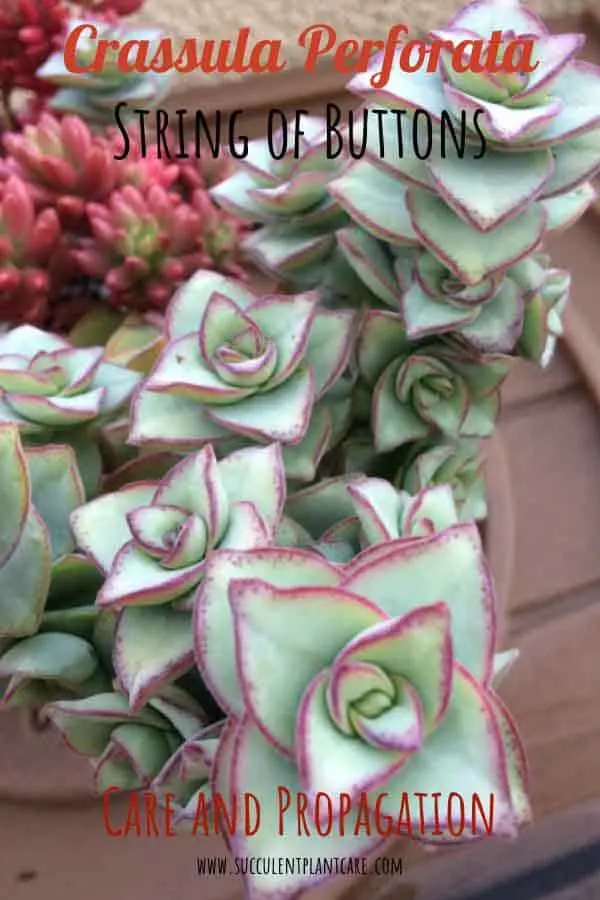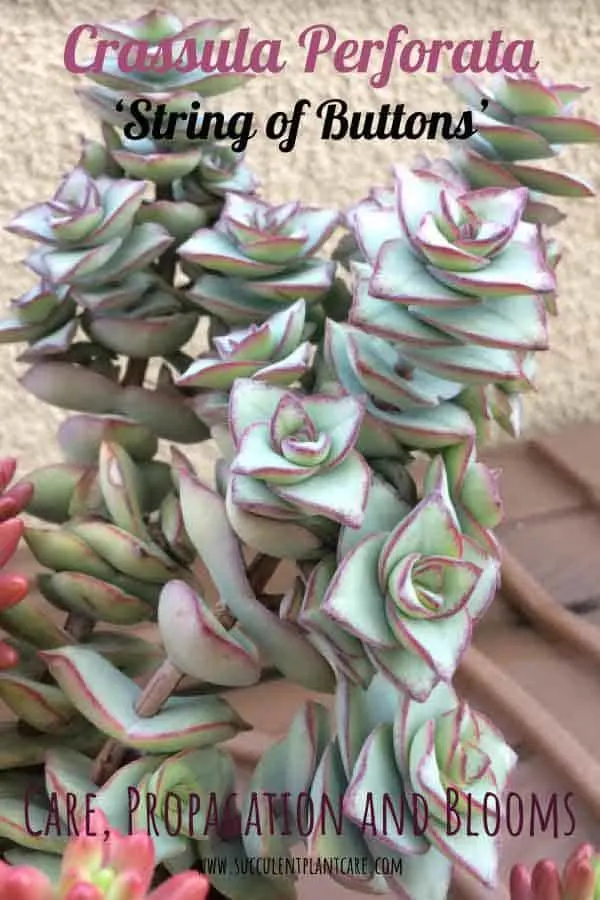Native to South Africa, Crassula Perforata (String of Buttons or Necklace Vine) are very attractive succulents that sprawl and stack on top of each other as they grow. They have small, tight leaves that appear to spiral around their stem.
The leaves are pale, bluish light green in color and lined with rosy pink to reddish pink edges. The pink color intensifies when exposed to more sun.
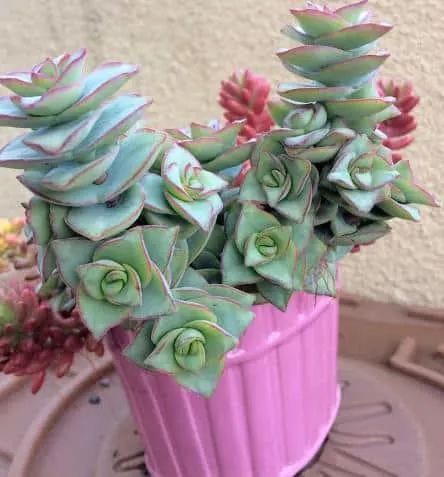
The plant grows straight up at first, then sprawls and appears to spill out of the pot as it matures. They can grow upto over 1 ft. (30cm) long. I never get tired of looking at my String of Buttons. Who could resist these amazing plants? They are so beautiful and look great in containers, hanging baskets and pretty much anywhere you stick them in.
Crassula Perforata ‘String of Buttons’ Care
Are They Indoor or Outdoor Plants?
Crassula Perforata ‘String of Buttons’ can be grown both indoors and outdoors. Whether indoors or outdoors, providing the right potting mix (a well draining one) along with proper lighting will give them the best chance at survival. I keep all of mines outdoors, under varying degrees of sun exposure. They seem to be happiest outdoors, but then again I live in sunny California where winters are mild.
Indoor Lighting Requirements
If kept indoors, provide as much light as possible. Typically speaking, they need approximately 4-6 hours of light per day to thrive. If your area does not receive adequate light indoors or if you have poor lighting, you may notice the plant stretching out or elongating. This process is called etiolation, where the plant does not receive adequate light for prolonged periods of time and begins to stretch out, literally seeking out more light. This process tends to produce weak stems and poor growth. When you start noticing your plant doing this, move it to a brighter location. Choose an east facing window. A south or west facing window will also work.
For poor lighting conditions, or for areas that do not receive adequate sunlight indoors no matter where you place your plant, consider using a growlight. Growlights are a good investment to have especially if you have long, dark winters. Here are some of my growlight recommendations.
To read more about this topic on indoor lighting for succulents, check out my post on “Proper Lighting for Succulents Indoors” to get some helpful tips.
Outdoor Sunlight Requirements
Crassula Perforata ‘String of Buttons’ do best in areas that receive plenty of sunlight. They can tolerate partial sun to full sun, but they prefer bright filtered sunlight. They need to be acclimated to full sun or the leaves will get scorched easily.
If kept outdoors, place in a bright sunny location. Before moving the plant outdoors or increasing the amount of sunlight it receives, it is better to acclimate the plant to help prevent sunburn or sun damage. Slowly increase the amount of sunlight it receives until it is fully acclimated to the sun. Keep in mind that even when the plant is already acclimated to full sun, it can still get sunburned during a heatwave or intense heat.
The rosy pink color on the edge on the leaves of the plant intensifies the more sun exposure it receives. To bring out the intensity of colors on your plant, increase the amount of sun it receives.
Crassula Perforata ‘String of Buttons’ are hardy in USDA hardiness zones 9-11.
Sunshades are a real lifesaver for my plants during the intense summer heat here in Northern California where the temperatures can rise above 100℉ or 37.8℃. Here are some of my recommendations for sunshades and sun protection.
For further details and information on outdoor sunlight requirements, please visit my post “How Much Sunlight Do Succulents Need Outdoors?” to get some useful tidbits.
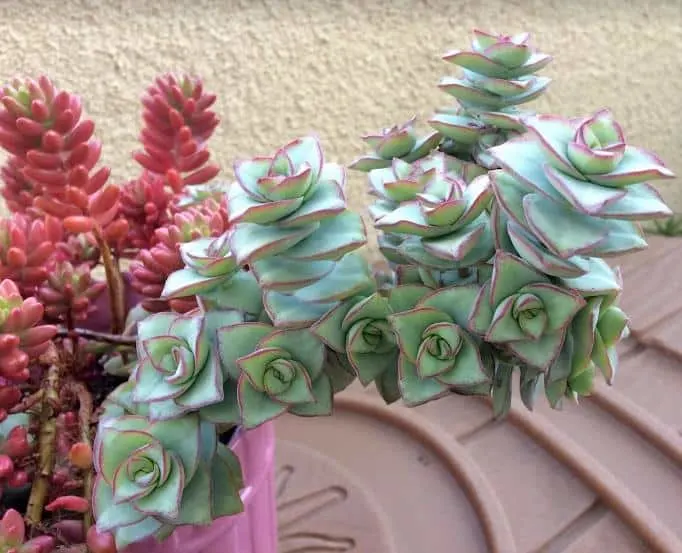
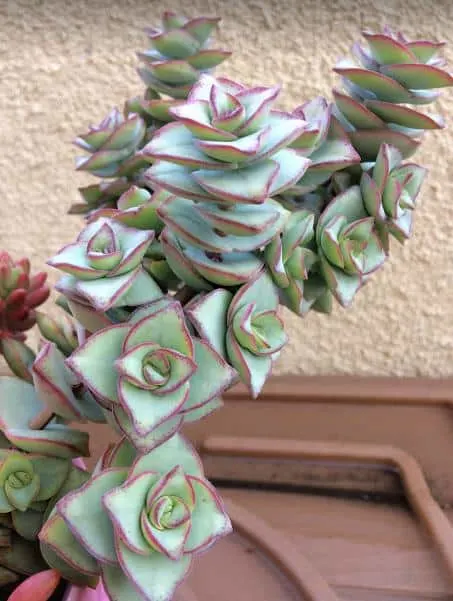
Frost Tolerance
Crassula Perforata can tolerate mild frost and freezing temperatures as long as they are not for long periods of time. If you live in USDA hardiness zones 9-11, you can leave the plant outdoors all year long and they can even be planted in ground. As I mentioned above, I keep mines outdoors all year long, and they survive the freezing rain and frost we experience in winter time.
If you have extreme winter conditions in your area, the best way to grow these plants are in containers. That way you can bring them indoors during winter or when there is forecast of frost or snow. In case you can’t bring them in, there are ways to protect the plants from frost and freezing temperatures outdoors. You can use frost cloths or mini greenhouses to help them survive the cold winter. Here are some of my recommendations for frost protection.
For more information on this topic, do visit my post on “Optimal Temperatures for Succulents to Thrive”.
Soil Requirements
Crassula Perforata needs a well draining soil. The right type of soil goes hand in hand with proper watering. I have been using a simple, tried and tested concoction that has worked well for my plants. I like to use a cactus potting mix combined with perlite for added drainage. I do not use exact measurements but eyeball it to about 2:1 solution of cactus mix and perlite. Others recommend using a sandy soil. This can be achieved by mixing cactus mix or potting soil with coarse sand (about 2:1 ratio). I get most of my materials from a local hardware store. You can also purchase them online. Here are my soil recommendations. To read more about soil for succulents, click on “Best Soil and Fertilizer for Succulents” to get more useful information.
Watering Requirements
Watering largely depends on the climate you live in. Although these plants are highly adapted to dry weather conditions, they do much better when given sufficient amounts of water. There really isn’t a set schedule or formula on when to water succulents. My watering schedule is dictated by the very dry climate I am in.
In the summer months, I water my Crassula Perforata as often as every 7-10 days, sometimes more during a heatwave. I cut back on watering to about every 10-14 days when the weather cools down. During the winter season, I mostly rely on rainwater and hold back on watering altogether because this is when we get a lot of rain in my area. But if we don’t get any rain at all during winter then I water at least once a month or every 2-3 weeks, depending on how dry the soil gets.
For those people in humid locations, you won’t need to water as much. And if you keep your plants indoors, you may not have to water as much especially if they are not receiving a lot of light. Too much water and not enough light is a recipe for disaster for these plants.
One good way to tell whether it’s time to water is to check the moisture of the soil. The top inch of the soil needs to feel dry before you can water again. If you are unsure how much and how often to water in the beginning, it’s always better to underwater and increase watering as needed. Pay attention to how your plant looks and you can adjust watering accordingly.
For further help with watering techniques, consider using tools like hygrometers or moisture meters to check for moisture in the soil and air. These tools are pretty affordable and can come in handy especially if you are unsure of when to water your plant next. I have narrowed down the choices here on my resource page. Do visit the page if you need help in gauging your watering needs.
Useful Tip: When watering, water the base of the plant or the soil area and avoid watering from the top of the plant to prevent leaf rot. The way Crassula Perforata plants are shaped, water can collect on the leaves and when they stay wet, rot starts setting in on the leaves.
Interested in finding out more about watering succulents? Visit my post “How And When To Water Succulents” where I go into details about this topic.
Propagating Crassula Perforata
The easiest and quickest way to propagate these plants is through stem cuttings. They can be propagated from leaves, but I find the process trickier and less foolproof than using stem cuttings. If you want to try to give leaf propagation a try, make sure to use the entire leaf which goes around the stem, including the base to ensure success. Slide the entire leaf down the stem to remove the entire leaf and lay flat on the soil. Propagating from leaves with this type of plant takes a little more time and patience. I have a much higher success rate with stem cuttings so I always opt for this method.
Propagating from Stem Cuttings:
- Obtain a stem cutting and let it dry for a day or so. Since the stems are thin they shouldn’t take that long to dry. It is also a good idea to obtain cuttings from healthy looking plants, not dehydrated ones or stressed plants.
(Optional) Dip the cut end in rooting hormone. I usually skip this step but some people prefer using rooting hormones to speed up the process and also guarantee success.
- Once the cut has healed and dried, stick the cuttings in a well draining potting mix.
- Keep away from direct sunlight. Water the soil every few days or when it feels dry.
- After about two weeks or so, you will notice new roots growing.
- After about four to six weeks, the cuttings should be fully rooted and you will soon notice new growth developing from the top or the sides of the stem.
- Once fully rooted, cut back on the misting and switch to regular watering about once a week or less. Increase the amount of sunlight as the plant matures.
With just a few simple steps, you can propagate your plant and have them growing everywhere. Please visit my post on “Easiest Way to Propagate Succulents” where I show how I propagated and spread my Crassula Perforata plant. It truly is an awesome feeling to be able to multiply your plant collection this way, and the best part is you get free plants in the end.
Crassula perforata stem cuttings that have rooted in soil.
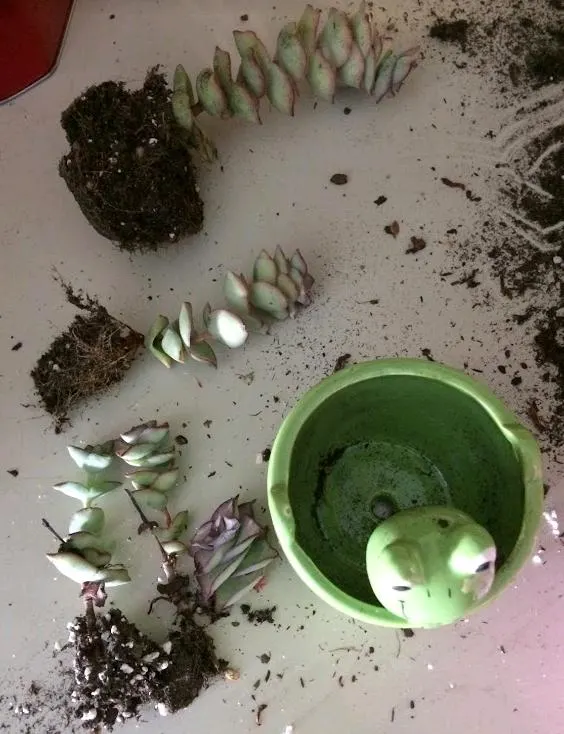
Common Problems with Growing Crassula Perforata
Brown Leaves
The most common cause of brown leaves on Crassula Perforata is sunburn. Although this plant can take full sun, any extreme weather conditions or extreme changes in weather such as a heatwave can cause sunburn or sun damage. This does not really internally hurt the plant as long as the problem is temporary. Prolonged sunburn under extreme heat can fry the plant to death, which has happened to me unfortunately (see picture below). If you notice the plant constantly getting sunburned, move the plant to a shadier location or provide shade under taller plants, furniture, or sun shades. If moving the plant to a sunnier spot, it is a good idea to do so slowly so you don’t shock the plant and you give it time to acclimate to the more intense heat. Remember, gradual changes are always better than drastic ones for any succulent plant.
Crassula perforata stems fried to a crisp
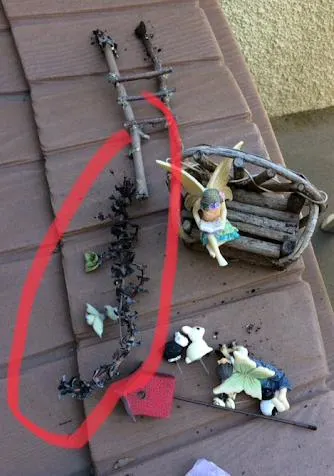
Shriveled Leaves
The most common reason for shriveled leaves on Crassula Perforata is underwatering. The leaves will appear shriveled, puckered and dried up. When touched, the leaves will feel flat and deflated. When this happens, it is a sign that the plant is running low on its water storage and it is time to water. Just give the plant a good drink of water and it should perk up immediately, usually within a day or so.
Mushy Brown Leaves
The most common reason for mushy brown leaves on Crassula Perforata is overwatering. The plant will look unwell and the leaves will get soft and mushy and appear translucent. These are telltale signs that you are overwatering your plant. Cut back on watering and allow the plant to dry out and recover from too much water. Do not water until the plant has had a chance to dry out completely. If the soil is not drying out fast enough, consider switching to a fast draining one. Root rot can develop when left in wet soil. Once you notice rot, you can still save the plant by cutting off the dead parts of the plant. Save anything that looks green and viable to propagate and repot.
Remember, it is easier to ‘fix’ an underwatered plant than an overwatered one so when in doubt, err on the side of caution when watering especially if you are not familiar with the plant.
How to Get Crassula Perforata to Bloom
Crassula Perforata produces clusters of white and yellow flowers. It is always a treat for me whenever one of my succulent plant blooms. Keep in mind that not all plants are ready to flower, and some may not bloom at all. A lot of it depends on environmental factors beyond our control.
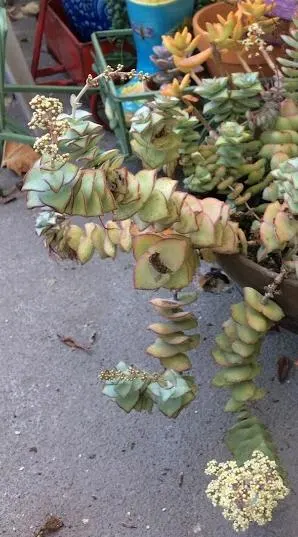
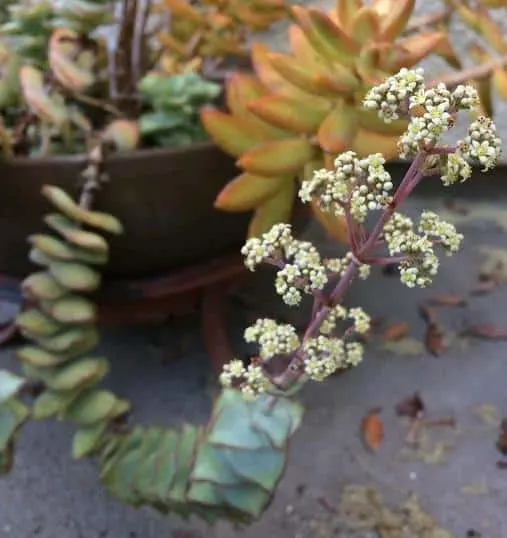
Here are some tips on how to encourage Crassula Perforata to bloom:
Plant Maturity
Make sure the plant is mature enough. When a plant blooms it means it is ready to reproduce. If the plant is too young, it is simply not ready to reproduce and therefore will not bloom. Give the plant some time, usually if the plant is over 3 years old and beyond, it is mature enough to bloom.
Plenty of Light
Make sure the plants are receiving adequate sunlight throughout the year and are kept in a bright location, even during colder winter months.
Proper Temperatures
To encourage flowering, provide proper temperatures. They need a distinct difference in night and day temperatures as well as summer and winter months. Succulents favor cooler outdoor nighttime temperatures of 50-55⁰F (10-13⁰C) or indoor night temperatures of at least 60-65⁰F(15-18⁰C). Especially when kept in a controlled environment, succulents prefer a marked difference between their night and day temperatures to mimic their natural habitat, with the cool night temperatures having an integral part in the plant’s growth cycle.
Overwintering
Overwintering is also important if you want to see your succulents bloom. This can be achieved by keeping them cool and relatively dry in the winter months, especially desert cacti. Keep them cool during winter months with temperatures just above freezing, between 35-44⁰F (1.5-7⁰C). If kept indoors during winter, have them in a non-heated room if possible or keep the temperatures low to provide them the cold winter period that they need.
Feed or Fertilize
While fertilizing is not necessary, giving your plants the nutrients they need will help ensure proper growth and encourage blooms. It takes a lot of energy for plants to produce flowers, and feeding them extra nutrients will help supplement their needs during flowering season. The most common recommendation is to fertilize during the active growing season, or during spring and summer months. Fertilizers are better applied at a quarter or half strength, about every two weeks. Refrain from fertilizing towards the end of fall season and during winter months. A balanced blend of fertilizer diluted to half strength is suitable and commonly used. Fertilizer blends specially formulated for cacti and succulents are also suitable.
Toxicity to Cats, Dogs or Pets
There is not enough information regarding the toxicity of Crassula Perforata to pets. The ASPCA does not list them as toxic to pets. Check out the ASPCA website for more information. If you suspect poisoning, contact your local veterinarian immediately or the ASPCA Animal Poison Control Center at 888-426-4435.
What are you waiting for? Go find yourself one of these beauties and see for yourself how great they are!
You may find this post on Crassula Rupestris ‘Baby’s Necklace’ helpful. These two are very similar plants in appearance and care.
Visit my resource page for recommendations on where to purchase these and other succulent plants online.
Pin this now to save for yourself or share with others!
